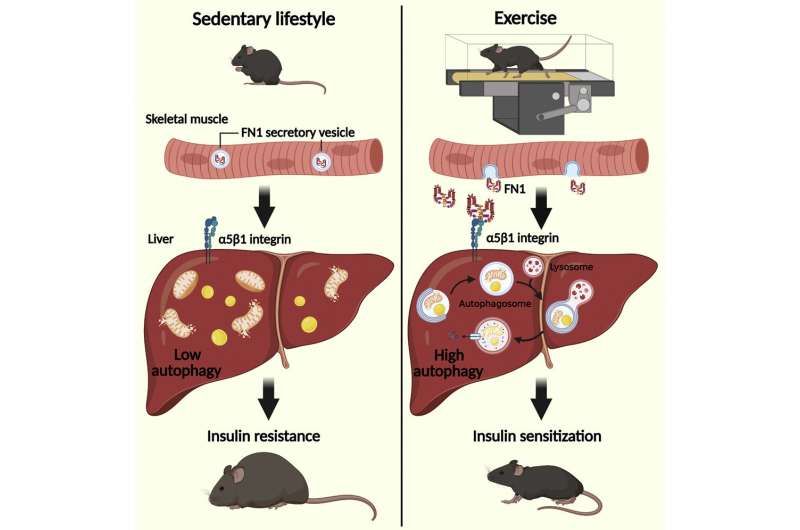This article has been reviewed according to Science X's editorial process and policies. Editors have highlighted the following attributes while ensuring the content's credibility:
fact-checked
peer-reviewed publication
trusted source
proofread
Understanding how exercise induces systemic metabolic benefits

Northwestern Medicine scientists have uncovered a mechanism by which exercise activates metabolic benefits in the body, according to a new study published in Cell Metabolism.
It's well known that exercise elicits many health benefits. However, how this is accomplished is not yet well understood. During exercise, autophagy, the body's cellular recycling system that allows old or damaged cellular structures to be broken down, is activated in both contracting muscles and various non-contracting organs, such as the liver.
In the study, investigators performed proteomic analyses on the blood of mice before and after exercise. They identified a protein secreted from contracting muscle, FN1, which significantly increased in the plasma and serum of mice after exercise.
The scientists then analyzed how FN1 communicates with the liver. They found that FN1 signals through a5b1 integrin, a membrane receptor on the liver, inducing autophagy and eliciting the metabolic benefits of exercise. Additionally, investigators found that mice lacking the FN1 gene in the muscle developed insulin resistance despite daily exercise, according to the study.
The findings aid in understanding exercise and how it benefits metabolism, said Congcong He, Ph.D., assistant professor of Cell and Developmental Biology and senior author of the study.
"We wanted to understand autophagy induced by physical exercise, especially in non-contractile tissues like the liver," said He, who is also a member of the Robert H. Lurie Comprehensive Cancer Center of Northwestern University. "Not only does this add to our understanding of the underlying mechanism of how exercise induces metabolic benefits systemically, but also how secretions from the muscle talk to the liver. We have now identified FN1 as a mediator of exercise-induced benefits via muscle-liver communication on autophagy."
Moving forward, He and her collaborators hope to further analyze FN1 to understand which elements of the protein activate metabolic benefits following exercise.
"The protein is fairly large, so we hope to chop it up into smaller peptides to see which are bioactive," He said. "Perhaps from that, we will be able to develop this as an injection for people who are unable to exercise to still get the metabolic benefits. For example, using this molecule as an insulin sensitization treatment."
More information: Kenta Kuramoto et al, Exercise-activated hepatic autophagy via the FN1-α5β1 integrin pathway drives metabolic benefits of exercise, Cell Metabolism (2023). DOI: 10.1016/j.cmet.2023.01.011





















